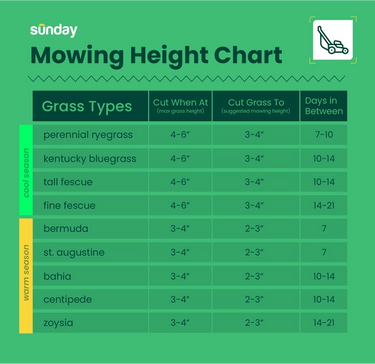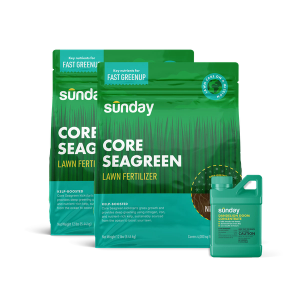Setting your lawnmower to the right level is one of the most important steps for a healthy, green yard. The best height to cut grass depends on your lawn type, and following the right mowing schedule helps your grass stay thicker, greener, and more resistant to seasonal stress.
Use the guidelines below to mow smarter and keep your grass happy.
Grass cutting height chart for common lawn types
Not sure where to set your mower? This quick video walks you through the best grass cutting heights for different lawn types:
If you’d rather scan the details, here’s the full chart broken down by cool- and warm-season grasses:

Cool-season grasses
- Perennial ryegrass: Cut at 4–6", mow to 3–4", every 7–10 days
- Kentucky bluegrass: Cut at 4–6", mow to 3–4", every 10–14 days
- Tall fescue: Cut at 4–6", mow to 3–4", every 10–14 days
- Fine fescue: Cut at 4–6", mow to 3–4", every 14–21 days
Warm-season grasses
- Bermuda: Cut at 3–4", mow to 2–3", every 7 days
- St. Augustine: Cut at 3–4", mow to 2–3", every 7 days
- Bahia: Cut at 3–4", mow to 2–3", every 10–14 days
- Centipede: Cut at 3–4", mow to 2–3", every 10–14 days
- Zoysia: Cut at 3–4", mow to 2–3", every 14–21 days
Lawn mowing tips for the best results
Beyond following the best height to cut grass, these mowing practices will help keep your lawn thick and healthy:
- Follow the 1/3 rule. Never cut more than 1/3 of the grass blade at once to reduce stress.
- Mow high. Taller grass develops stronger roots and naturally shades out weeds.
- Recycle clippings: Leave clippings on the lawn when possible to return nutrients to the soil.
- Keep blades sharp: Sharp mower blades give clean cuts that heal faster and improve lawn appearance
Smarter mowing for a healthier lawn
By following this grass cutting height chart and mowing schedule, you’ll set your lawn up to resist drought, crowd out weeds, and stay green all season long.
Looking for more mowing advice? Check out:
Let's get growing
Our lawn engine uses satellite data to map out your lawn size and determine things like average rainfall, common weeds, and pest activity.


















